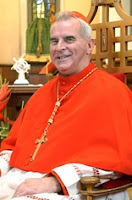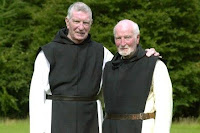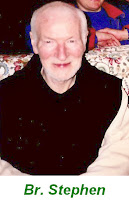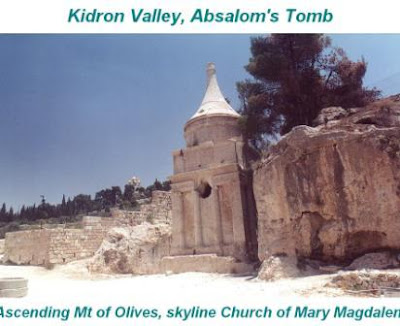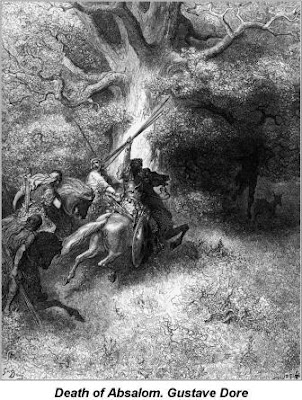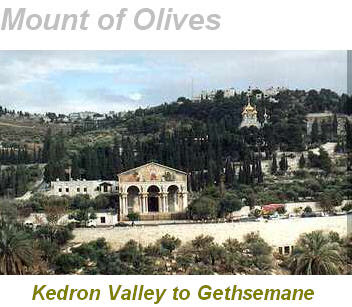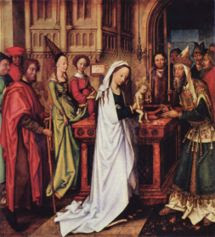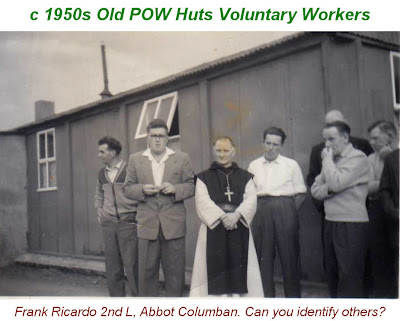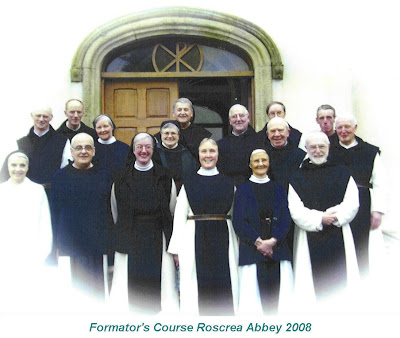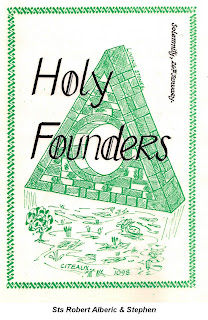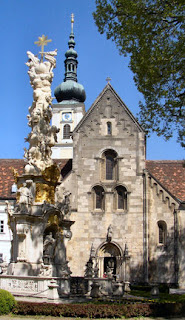Mass for the Golden Jubilee of the Ordination to the Priesthood of Fr Raymond and Fr Hugh 1st March 2008
Homily by the Prior, Fr. Mark
 [First
[First
Second Reading 1 Cor 1:3-9
Gospel Jn 15:9-17]
It is so unusual in today’s world to have a double celebration of the golden Jubilee of two priests, never mind one!
The day I heard I might be preaching on this jubilee, the gospel was from Luke 15:11-32. Appropriately it was about two brothers. So far so good! The problem is that it was the parable of the prodigal son and his elder brother. This is more than one problem. One of them got itchy feet and left home, no doubt with his own credit card. The other seems to have been a lot older, with perhaps more stability than his younger brother and apparently more sense in his make up. And here, today, we have two venerable seniors with as much mature wisdom and magnanimity as you could imagine.
I suppose this is as bad a beginning as I might have feared. But, since I’ve started I’d better continue!
Before you think we are still at the penitential rite rather than listening to an elevating homily about Fr Raymond and Fr Hugh, it is right to remember that the priesthood like every Christian vocation is caught up in the ebb and flow of everyday living, with its good and not so good seasons, with it’s inspiring and less admirable aspects. The thing is we all start off with the greatest of ideals, the purest of motives and the desire to help those we see to be in need of help. This is as it should be. But it is also unreal. It is unreal because Fr Raymond and Fr Hugh, as we all were, were very much green gangling novices, at this stage. They were only at the start of the process, begun indeed by the Holy Spirit. They themselves weren’t yet fully part of that divine working. They needed time to be shaped and strengthened in their resolve. It is a relief to hear the words of the first reading that “they are sons and no rogues”. And so in the years that followed they have shown the wonder of their vocation in their real love for God here in the monastery. In this place they have worked and prayed, and cared for the needs of the community in all things both material and spiritual, serving the needs of one another and helping them to grow in the knowledge and love which comes from a faithful listening to the word of God, day by day, from the early vigil hours to the final praise of God before the coming night. Each day began for them in the Church and ended there before going to bed where they would find their rest. Refreshed, they would start the next new day, continuing all the time the work of God in whatever form it presented itself each day of their monastic lives. It is surprising how much can be done within such a routine and to what extent it affects the inner life.
Fr Hugh and Fr Raymond have come to live that life fully, as all monks are called to do. This is a far cry from the vocation of the priest in the parish who has to deal with the practical pastoral realities of parish life. In some cases however there is a crossing over of roles. Our two jubilarians are a good example of this. They have both had their own fair share of truly spiritual and pastoral work. Fr Raymond, as so many of the guests and friends of the abbey have witnessed, has been a tower of strength and assistance to a great many visitors to Nunraw over the twenty or so years he has served as Guest Master and now as abbot of the community. He has given of himself at all sorts of unseasonal hours and in difficult situations to the needs of others at great cost to himself. And God’s love has grown in him through it all. His wonderful sermons are probably a result of this earthy compassion. Both he and Fr Hugh have enriched us with their teaching and preaching about the graces of God. And, like Fr Raymond, Fr Hugh has been unsparing over the years in his work in the confessional. He has even become the local curate, supplying over the years for our PP, Canon Friel, in Haddington when the need has arisen. Fr Hugh has even spent some time in prison. No, he wasn’t apprehended like an erring, prodigal son trying to avoid the police as he was returning home to his loving Father. In truth, he went as a guest of the prison chaplain, Fr John McFadden who is present with us today, to see something of the inside of a prison, and to meet some of the prisoners for himself. Contrary to expectations, it wasn’t quite like Nunraw. It hasn’t been recorded which place he preferred.
When all is said and done, the life of a priest, of a monk, of a Christian, is not at all unlike the story of the prodigal son and his elder brother. We all have the gift of the one, loving, compassionate Father. And, we are all to some extent like the younger son with our own desires to get away and experience ‘real’ life in the raw. But we are also all a bit like the elder son with our own ideas of what a good, sensible and proper son should be. Unfortunately we also harbour the unpleasant and unlikeable characteristics we see in the elder son’s reactions to the return of his younger brother. In this parable, we see the true workings of the human heart and how we all have need of the loving arms of our Father around us when we return to him. We all need, too, the welcoming love and compassion of the Father whether we are the younger brother or sister returning home. We also need to appreciate the warmth and understanding of this same Father if we have stayed at home. If we can break free from our lack of compassion and hardness of heart we will know that we likewise are accepted and loved as the elder brothers and sisters that we are.
Today’s gospel reading gives the same message of the parable of the two brothers: Love God and especially one another. That surely is what the priesthood is all about, to be preachers and teachers and men of God so that others can be people of God. That is what gives us cause to celebrate with Fr Raymond and Fr Hugh today.
There is one remaining Big P. S. to add:
Yesterday morning when I went into the Church for our very early Office of Vigils, I could see that Fr Hugh was missing. This was most uncharacteristic. I thought, “Oh, my God, maybe he has died during the night. Don’t tell me I’ll have to rewrite my homily.” What had happened was that he had been suffering from a minor ailment. The doctor gave him some medicine that hadn’t agreed with him and he became quite sick. That was the reason he was missing from Vigils. You can imagine my relief. As you can see today he has happily recovered and well enough to celebrate his Golden Jubilee.
For this and for all that our two, to be honest not younger brothers, have done, and been, let us now give thanks.
Message from Cardinal Keith P. O’Brien
Date: Friday, 29 February, 2008
Subject: Congratulations to Abbot Raymond and Father Hugh on your 50th anniversary of ordination.
Dear Raymond and Hugh,
My sincere congratulations to you both as you celebrate the 50th anniversary of your ordinations to the Priesthood.
However my thoughts and my prayers will be with you both and I will offer the Holy Sacrifice of the Mass for you both in thanksgiving,
As I indicated just a few days ago at the funeral of Brother Stephen I myself have celebrated the golden jubilee of my own links with Nunraw. Who would ever have thought our paths would have led us to where we are now! I myself will soon be rejoicing at having served the Archdiocese for twenty-three years as Archbishop - while you both have been continuing your life of prayer and penance at Nunraw. Over those fifty years many things are different from the way they were fifty years ago - but stability in our various lives has been found in our love and service of Jesus Christ and of his people particularly sharing the Sacrifice of Christ day by day as we celebrate Mass, myself in the Archdiocese or throughout the world and yourselves here in your Monastery at Nunraw.
As we celebrate our various anniversaries the call to vocations to the Priesthood and religious life must continually re-echo.
I join with you, yes, in thanking God for all the great gifts and the many graces he has given to you both and now pray that there will indeed be that increase in vocations to the Priesthood and the religious life in the years which lie ahead.
Do continue to remember me as I remember you both and look forward to seeing you in the not too distant future.
Yours sincerely in Christ
Keith


